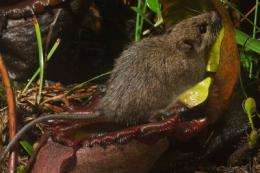A pitcher perfect relationship

(PhysOrg.com) -- It seems counterintuitive, but in rare cases carnivorous plants and herbivorous animals nourish each other in a mutually beneficial relationship.
Now, Monash University researchers have recently found that the carnivorous pitcher plant of Borneo takes the quest for nutrition a step further, establishing mutualistic relationships with more than one species of animal.
In research published in the journal PLoS ONE, Monash University biologists in Australia and Malaysia, have discovered an apparently unique situation where two species of small mammals, mountain treeshrews and summit rats, both feed on and feed pitcher plants.
Dr Rohan Clarke and Melinda Greenwood of the School of Biological Sciences, Dr Charles Clarke from the Malaysia School of Science, together with Ch’ien Lee from Kuching and Ansou Gunsalam from Sabah Parks discovered the multi-directional relationship while undertaking field research on pitcher plants.
The pitcher plant, common throughout South East Asian tropics, tends to grow in nutrient-deficient areas. To compensate for this they grow large, jug-shaped leaf organs in which they trap and digest insects, spiders and other arthropods.
The treeshrews and summit rats are attracted to carbohydrate-rich secretions produced by glands on the pitchers’ lids. After feeding on the nectar, the mammals defecate in the pitchers, providing much needed nutrients to pitcher plants.
Dr Rohan Clarke said that the team was conducting initial investigations to expand on previous research that had discovered the relationship between pitcher plants and mountain treeshrews, when it became apparent that the summit rats were also engaging in mutualistic nutrient exchange.
“What we’re looking at is a very specialised nutrient acquisition strategy on the part of the pitcher plants. That is, rather than just trapping insects, the plants seek a secondary food source in the form of scat from larger animals, which the plants lure with nectar secretions around the pitcher.
“The cooperation goes further – the rats and treeshrews visit the pitcher plants at different times, allowing them to exploit the same resource while avoiding direct competition with each other," said Dr Clarke.
“Previous research had shown that this relationship existed between the pitcher plants and treeshrews. Our study is the first to show that the pitcher plants are engaged in this kid of mutualistic relationship with multiple species of mammal. It’s a good example of just how adaptable nature can be.”
More information: www.plosone.org/article/info%3Adoi%2F10.1371%2Fjournal.pone.0021114
Provided by Monash University

















